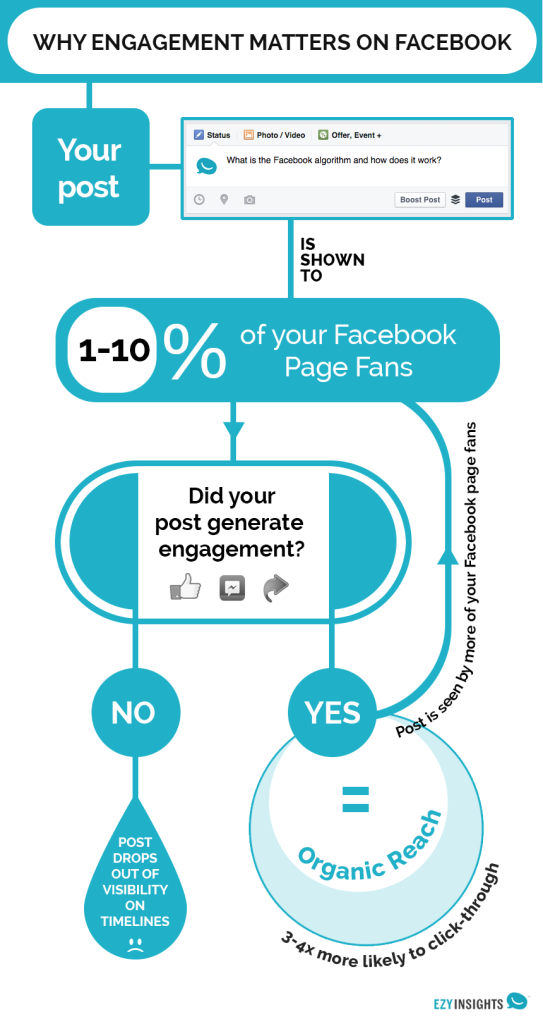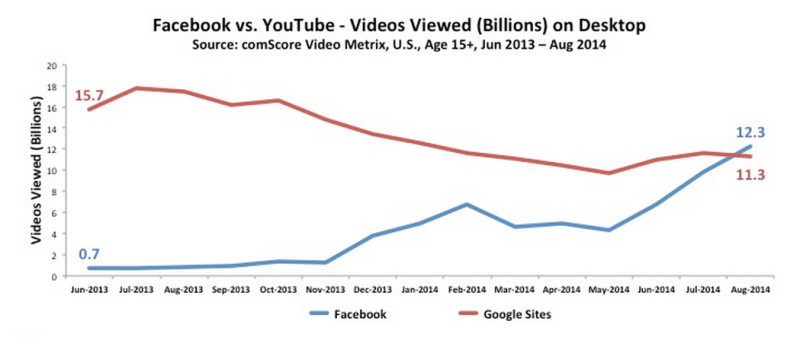The reach trend is real
Facebook recently made an announcement mentioning the ever decreasing organic reach for brands on the platform. In particular the statement mentioned the following:
According to people we surveyed, there are some consistent traits that make organic posts feel too promotional:
- Posts that solely push people to buy a product or install an app
- Posts that push people to enter promotions and sweepstakes with no real context
- Posts that reuse the exact same content from ads
Posts that contain these traits are made and posted by brands because in the past it was precisely this type of post that generated the best results in terms of reach on Facebook. I am sure you have all seen several posts in your own Facebook newsfeed – the type that contain a competition asking you to like, share, comment or tag a friend (even two!).
These types of posts have worked because they generate active engagement. Active engagement means visible interactions with the post that the Facebook newsfeed algorithm uses to determine the importance of that post. The more important, the more people it is shown to – aka higher reach. These engagements are very simple: likes, comments and shares. Invisible or passive engagements include clicking on a photo to enlarge it, or clicking on a link to read an article – this type of action is not shown to others, you won’t see a post that says a friend of yours clicked on a photo, but it still counts in the newsfeed algorithm. Facebook does know and record these invisible engagements and they do count towards a post’s importance.
Most of the people reading this post will already have an idea of how Facebook’s newsfeed algorithm works. Here’s a diagram that shows in a very basic way what happens to a post that is made on Facebook:

How the Facebook newsfeed algorithm works in a nutshellFacebook also said:
“News Feed is already a competitive place – as more people and Pages are posting content, competition to appear in News Feed has increased. All of this means that Pages that post promotional creative should expect their organic distribution to fall significantly over time.”
The average person sees about 300 posts in the newsfeed every day and it’s the newsfeed algorithm that determines which ones you’ll see out of the 1500+ that could potentially be shown to you. Where Facebook and brands clash is the goal they are both trying to achieve.
- Brands want as much reach as possible, regardless of how much value the content brings to the viewer.
- Facebook wants users to see posts they like and get value from.
- People don’t like seeing adverts dressed as posts (little to no value to them).
It’s only natural then that to improve the Facebook experience for users, Facebook themselves must ensure that users see less of the posts they don’t like. This is at the expense of brands who have been used to reaching a certain proportion of their page fans in the past. The actual number of page fans that a page has means less and less.
From a user’s point of view, this is good news. It means more funny cat pictures you love and less boring posts from shops and businesses, at least in your organic newsfeed. Where there has been confusion for Facebook users is the number of real adverts they see on Facebook. These are posts which have the word ‘sponsored’ under them somewhere. These adverts are unavoidable – they are part of the Facebook experience because they are a source of revenue that allows Facebook to keep the platform running. The rough proportion of advertised posts that a user will see in their feed is 5%. So an average user viewing 300 posts a day will see about 15 adverts directly in their newsfeed. No amount of clicking ‘I don’t want to see this’ will change that – you’ll just see an advert from a different (possibly less relevant) brand. Facebook of course also works to ensure that adverts are targeted well – so there is at least the possibility that when you see one it will be for something you actually consume or could use. The better the ads, the more effective they are and the more brands will be willing to pay for you to see them.
Facebook therefore needs brands and it needs them to pay to be on Facebook and show their posts to users and they expand on the details these changes may make to brands in this post. Ultimately, most brands will not be unduly affected because most brands post infrequently enough for it not to bother anyone. It will and should affect brands who pump out content that is not useful or valuable to users and through incentives like competitions manage to make users feel swamped with posts they aren’t interested in. After all, the latest competition to win a €15 gift voucher from some high street store that you see because you were tagged in could have been a post from a real friend.
Which businesses aren’t affected by this?
As mentioned, most brands don’t put out enough content to be significantly affected. The brands that these changes shouldn’t affect and may even benefit are those which have content to post. What does that mean – it means pages like Buzzfeed, BBC News, Techcrunch, bands, TV shows and other similar pages. These outlets are providing content that people consume regularly and also happen to enjoy. Facebook favours this type of content significantly over brand messages. Facebook understands that users will click through to content and spend a significant amount of time away reading or watching or listening before coming back. It actively promotes this by tracking how long you spend away from Facebook when clicking through to another site. If you click through to a useless story that doesn’t hold your attention or deliver on the promise it made in the headline, Facebook’s algorithm punishes that. So if you click through and return within a few seconds (especially under 15 seconds), Facebook will assume that content is not valuable and will limit the reach for that post and eventually that page. If however you click away and watch a 5 minute video, browse a few other pages on the site you went to and then return some minutes later, that is considered a success and Facebook will give more priority or importance to this post and page in the newsfeed algorithm.
Important to remember:
Post links to quality content.
Ensure where possible that users can consume more related content directly afterwards.
Use native Facebook video.
This brings me on to my final point – native Facebook video. I’ll start with this astounding stat:

Facebook had more videos viewed on desktop than YouTube in August 2014. (Source: http://marketingland.com/facebook-delivered-a-billion-more-desktop-video-views-than-facebook-103778)
That’s right – Facebook is serious about video.
Right now, natively uploaded Facebook video content (NOT YouTube content), is getting a significant reach boost. The other big advantage that video uploaded directly to Facebook has is autoplay. The vast majority of people do not turn off autoplay. This is a small but significant difference to how Facebook treats Youtube content which does not autoplay. It means any brand posting video content has a big advantage in capturing your initial 3 seconds of attention. If you’re a company that posts video content and you’re not uploading 15-30 second videos directly to Facebook, you need to ask yourself why not.
Of course some brands and media companies have their own video channels and are as such reluctant to post directly to Facebook. This is the exact same problem brands initially had believe it or not, about posting content on Facebook. We’ve seen that content on Facebook which is seen through a friend rather than via the brand has a 3-4 times higher chance of being clicked on. Video will follow the same path – if you can get 3 seconds of attention, you have a chance to get 30 seconds. If you can get 30 seconds, you have a chance to get the 3 minutes plus of attention that longer form content online requires.
What does that mean for me?
If you have longer form video content, post 15-30 second teasers on Facebook directly. If you have short form content – try posting it directly to Facebook for a week and see the difference in reach you get. Every time we have seen organic/viral reach go up, clickthroughs go up exponentially. Result: happy users, happy brands, happy Facebook.
Remember – we specialise on driving more traffic to media companies from Facebook and other social platforms. If you want to know more about how these things work or what you could be doing better – drop us a line any time.
Thanks for reading!
-Steve
